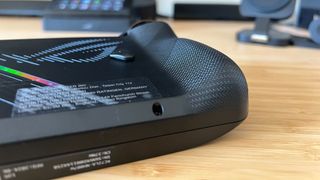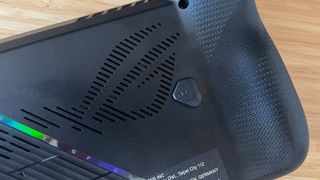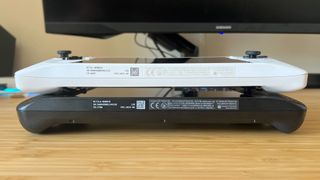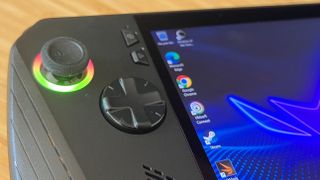12DOVE Verdict
The Asus ROG Ally X is a neat addition to the brand’s range, and the top handheld in the lineup, but it’s far from the best value for money. Every upgrade in here is warranted, and worth it if you can spring the cash, but the core experience remains relatively similar throughout. These new features are worth the extra $100 compared to the original device’s $699 MSRP, but the Ally still has its place on the shelves with its now reduced $549.99 sale price.
Pros
- +
Boosted battery life
- +
More RAM with higher bandwidth
- +
Improved thumbsticks and face buttons
- +
Better ergonomics
- +
Display still looks super crisp
Cons
- -
Slightly heavier and chunkier
- -
Back buttons are harder to hit with smaller hands
- -
Same processor as cheaper Z1E
Why you can trust 12DOVE
The Asus ROG Ally has taken over my life since it launched last year, with my PS5 (and particularly my Nintendo Switch) taking a backseat when it comes to play. So I was excited when I heard of rumors swirling around a second model. The Asus ROG Ally X isn’t so much a successor to the original model, and more like a mid-cycle refresh we might see in a console. The headline here is that doubled battery size, but with additional RAM and storage, new cooling tweaks, and some ergonomic chassis developments this is still a noteworthy upgrade.
Considering the ROG Ally X starts at $799 ($100 more than the original Z1E at launch, though you’ll regularly find that model at $549 - $649 these days), this is no impulse buy. I’ve spent the last two weeks running the Ally X alongside my original device to see exactly what that cash gets you from one of the best gaming handhelds currently on the market.
| Header Cell - Column 0 | Asus ROG Ally X | Asus ROG Ally |
|---|---|---|
| Price | $799 / £799 | $649.99 / £599.99 |
| Processor | AMD Ryzen Z1 Extreme Processor | Zen 4 architecture, 8-core /16-threads, 24MB total cache ,up to 5.10Ghz boost | AMD Ryzen Z1 Extreme Processor | Zen 4 architecture, 8-core /16-threads, 24MB total cache ,up to 5.10Ghz boost |
| Graphics | 12 RDNA3 CUs, up to 2.7GHz, 8.6 TFLOP | 12 RDNA3 CUs, up to 2.7GHz, 8.6 TFLOP |
| Display | 7-inch FHD IPS at 16:9, 120Hz, 500 nits peak brightness, 7ms response time, Dolby Vision HDR, AMD FreeSync Premium | 7-inch FHD IPS at 16:9, 120Hz, 500 nits peak brightness, 7ms response time, Dolby Vision HDR, AMD FreeSync Premium |
| Memory | 24GB LPDDR5-7500 | 16GB LPDDR5-6400 |
| Storage | 1TB PCle 4.0 NVMe M.2 SSD | 512GB PCle 4.0 NVMe M.2 SSD |
| Ports | 1x 3.5mm audio, 1x USB 3.2 Gen 2 Type C (DisplayPort / Power Delivery), 1x Type C USB 4 (Thunderbolt 4, DisplayPort 1.4, Power Delivery 3.0), 1x UHS-II Micro SD card reader | 1x 3.5mm audio, 1x ROG XG Mobile Interface, 1x USB Type-C 3.2 Gen 2 (DisplayPort 1.4), 1x UHS-II Micro SD card reader |
| Controls | ABXY, D-pad, 2x triggers, 2x bumpers, 2x back buttons, 2x thumbsticks, View, Menu, Command Centre, Armoury Crate | ABXY, D-pad, 2x triggers, 2x bumpers, 2x back buttons, 2x thumbsticks, View, Menu, Command Centre, Armoury Crate |
| Connectivity | WiFi 6E, Bluetooth 5.2 | WiFi 6E, Bluetooth 5.2 |
| Battery | 80Whrs | 40Whrs |
| Dimensions | 28 x 11.1 x 2.47 - 3.69 cm | 28 x 11.1 x 2.12 - 3.24cm |
| Weight | 678g | 608g |
Design
Asus has used a brand new black colorway to differentiate its X model on the shelves, and while I’m normally a fan of crisp white tech, I have to say I prefer it. It looks a little more Steam-Deck like and runs the risk of being confused with the MSI Claw, but overall this is a far more slick aesthetic. I’ve been running my Ally for a year now, and that white textured plastic can pick up some crap - this thing’s going to look much cleaner in the long-run.
Of course, that’s not all Asus has changed about the ROG Ally X’s design. The actual shape of the handheld has been through some updates as well. Each side features a more pronounced hump over the grip area, compensating for a slight increase in weight with far more stability in the actual hands. I have far more purchase when holding the device with both hands and with one and, while the original never threatened to slip from my grip, the whole unit feels more secure as a result. It’s also more comfortable than the original, particularly when lying down.

The sloped sides at the front of the original Asus ROG Ally have also been softened. These palm rests sold the Ally to me when I first picked it up out the box, but the less graduated version on the X model still feels comfortable, especially with the smaller back buttons to the rear. I have smaller hands, so I never really encountered the issues that many reported with the back paddles on the older model. However, I can see how they would be easy to accidentally press during gameplay, even if the only time I hit them unnecessarily is when picking the device up.

Those with larger hands are going to find the much smaller ROG Ally X back buttons far more accurate. The way my hand naturally rests, gripping the sizes with two fingers on the bumpers, however, means they’re harder to reach for. I’m not the biggest fan of the hollow-feeling back buttons on the original, but I do prefer their extra size compared to these nubs.
There is a little extra chunk to contend with, though, that might be getting in the way of me hitting those back buttons with smaller hands. However, I am impressed that Asus has managed to keep this bulk down, even while doubling the battery, upgrading the cooling, and squeezing in more RAM and storage.

The max thickness of the ROG Ally X comes in at 3.69cm, whereas the original is 3.24cm at its chunkiest point. That’s only a 40mm difference between the two, when I was expecting at least an extra cm when reading those early spec leaks. The weight bump from 608g to 678g is barely noticeable in the hands, and didn’t add any discomfort during my testing.
Features
The Asus ROG Ally X has a whole roster of new specs to keep things interesting, but I’ll start with the upgrade we’ve been crying out for. The new model features double the battery power of the original, with an 80Whr charge compared to the original’s 40. Considering this was one of the biggest factors holding the Ally back compared to the competition, that’s a revelation. Asus’s official marketing puts the real-life play time at around three hours on a moderately demanding game, and eight hours in smaller titles. I generally kept my Ally plugged into the wall before the Ally X, but I can confidently say the improved battery has freed me up to move with the device far more. A real-world battery test using Octopath Traveler at 25W and full brightness (no Aura RGB) put the original Asus ROG Ally at a two hour battery life. The same settings on the Asus ROG Ally X had me running for about 3.5 hours before having to plug in - that’s no small change.
There are two more upgrades under the hood, but I would argue one is far more important than the other. The new Asus ROG Ally X ships with a boosted 1TB SSD to help you keep more games on the go - but if you’re like me and prefer to be economical with your downloads, that’s not as big a deal as the upgraded 24GB RAM. While Asus has kept the same AMD Ryzen Z1 Extreme processor at the helm, that boost in memory makes games like Alan Wake 2 and Baldur’s Gate 3 far more accessible. Both titles recommend 16GB for the smoothest experience, but it’s difficult to devote all those GB to one place. The ROG Ally X allows for a 16 / 8 GB split between system and video, but also boosts you up to 7500MT/s sticks rather than the original’s 6400MT/s - giving that Z1 Extreme more to play with at the same time.

In every day, play, though it was the thumbsticks that stuck out most to me. Even on my first round of testing the original model, I was disappointed with how loose the sticks were - it makes everything feel a little cheaper overall. However, these have been tuned right up for the X, with greater tension behind every pull for a far more slick experience. There’s also a slightly deeper thock to the face buttons, with slightly more force required to actuate but a far more satisfying sensation as a result. The D-Pad has also seen its own glow up. This is now an 8-gate pad for a wider range of flexibility in your controls. That’s not going to make too much of a difference outside of isometric indie adventures or fighting games, but it does feel better under the fingers.
Asus has dropped the same screen in between those controls as the original, and while its bezels remain you’re still getting a solid display. It’s a 120Hz 1080p panel so everything looks slick and smooth, with a variable refresh rate ready to catch you should those frames drop. There’s no panel overhaul here, like Valve’s latest Steam Deck OLED iteration, but it’s a crisp, shining picture nonetheless.
Above that, though, we have another new feature that I’ve been wanting for a few months now; a second USB-C port. Too long have I had to rely on a Bluetooth connection when using a wireless gaming headset on the Ally - now I can just plug in a USB-C 2.4GHz dongle can still stay charged. That’s an excellent boost, but it does come with the sacrifice of the proprietary port for the Asus ROG XG Mobile, an eGPU that can bump your docked play up to RTX 4090 levels of power. Of course, very few Asus ROG Ally owners are spending $2K on this extra accessory - but if you’re among them it’s well worth noting that the ROG X simply isn’t compatible. The USB-C port we do have, however, is also a Thunderbolt 4 number, which means you’re getting a much wider pool of eGPU enclosure options open to you, but also more powerful docking opportunities.
Finally, we’re diving inside the Asus ROG Ally X for a look at its new cooling features. The brand has popped an extra vent on the top of the device, while halving the thickness of the actual fan blades. That means more air being moved through the chassis and much cooler temperatures overall.
Performance

Technically, the Asus ROG Ally X shouldn’t boost the performance of your games by too much. It’s leaning mostly on the expanded RAM room to bump up its framerates by a marginal amount, with this year’s refresh simply adding extra features on top of the kind of power you’ll get in the regular ROG Ally. That extra memory isn’t just sitting back, though, it’s giving everything else a lot more breathing room, even in games that don’t need to push past the full 16GB of the original model.
| Header Cell - Column 0 | Asus ROG Ally X | Asus ROG Ally |
|---|---|---|
| TimeSpy | 3,514 | 3,292 |
| Fire Strike | 8,031 | 7,389 |
| Assassin's Creed: Valhalla | 37fps | 32fps |
| Shadow of the Tomb Raider | 43fps | 39fps |
The Asus ROG Ally X beat the previous version in both Time Spy and Fire Strike scores and in-game benchmarks. It’s not by much, sure, but considering this is the same silicon it’s still a result. A jump from 32fps to 37fps in Assassin’s Creed: Valhalla isn’t enough to have you running to the stores by itself, but taken with all the other feature upgrades on offer this year it’s still a solid boost.
Should you buy the Asus ROG Ally X?

I’ll be real with you, I didn’t expect the bigger battery of the Asus ROG Ally X to change my life. And it hasn’t. Gaming handhelds just aren’t at a place yet where a battery can last a full four-hour flight no matter what you play, and there’s no point in telling ourselves that the Ally X will change that in exchange for an extra $200. With the same processor and display as the original model, this is an upsell rather than a must-have.
Still, if you’re new to the scene and wondering which version to buy there is a case for the 2024 iteration. If battery life is your main concern, and you mostly play heavier titles, then the X is going to make serious sense. The extra RAM under the hood can also help you out of a jam when it comes to newer, more demanding releases. On top of that you’re getting a more comfortable grip and better controls, all with double the storage space under the hood. Considering the ROG Ally X actually sees real uplift in framerates despite packing the same processor as the original is also particularly impressive.
The original model is regularly available for just $549.99 these days, though, making it the go-to for anyone after the best value - or players who, like me, tend to play while plugged in anyway.
If you’ve already got a ROG Ally, then there’s very little point in upgrading at full price. Best Buy is currently offering a $180 discount on the price of the ROG Ally X with the trade-in of a ‘Good’ condition device and all the associated cables. That means you’re still paying over $600 for a couple of extra hours play and boosted capabilities for maybe two or three games a year. If each new feature ticks a box for your needs then it’s worthwhile, but if it’s just one or two extra bonuses that have your interest, I’d at least wait for some price drops.
How we tested the Asus ROG Ally X
I used the Asus ROG Ally X as my daily driver for two weeks, testing directly against the original Asus ROG Ally Z1E in that time. I primarily played Octopath Traveler, Assassin’s Creed: Valhalla, Fallout 4, and Gears Tactics during that time, while also benchmarking across Shadow of the Tomb Raider, 3D Mark Time Spy, and 3D Mark Fire Strike as well. For more information on how we make all our recommendations, check out the full 12DOVE Hardware Policy.
We're also bringing you all the best gaming laptops we've tested as well as the best gaming PCs and the best gaming tablets for more play on the go.

Managing Editor of Hardware at 12DOVE, I originally landed in hardware at our sister site TechRadar before moving over to GamesRadar. In between, I've written for Tom’s Guide, Wireframe, The Indie Game Website and That Video Game Blog, covering everything from the PS5 launch to the Apple Pencil. Now, i'm focused on Nintendo Switch, gaming laptops (and the keyboards, headsets and mice that come with them), PS5, and trying to find the perfect projector.

Filming has started on the second season of beloved Hulu show Paradise, only weeks after the hit Disney Plus show ended

Reacher star is being fan-cast as the MCU version of Tom Hardy's fan-favorite Spider-Man character

This Avengers: Doomsday theory suggests that X-Men Days of Future Past may have created Robert Downey Jr.'s Doom










